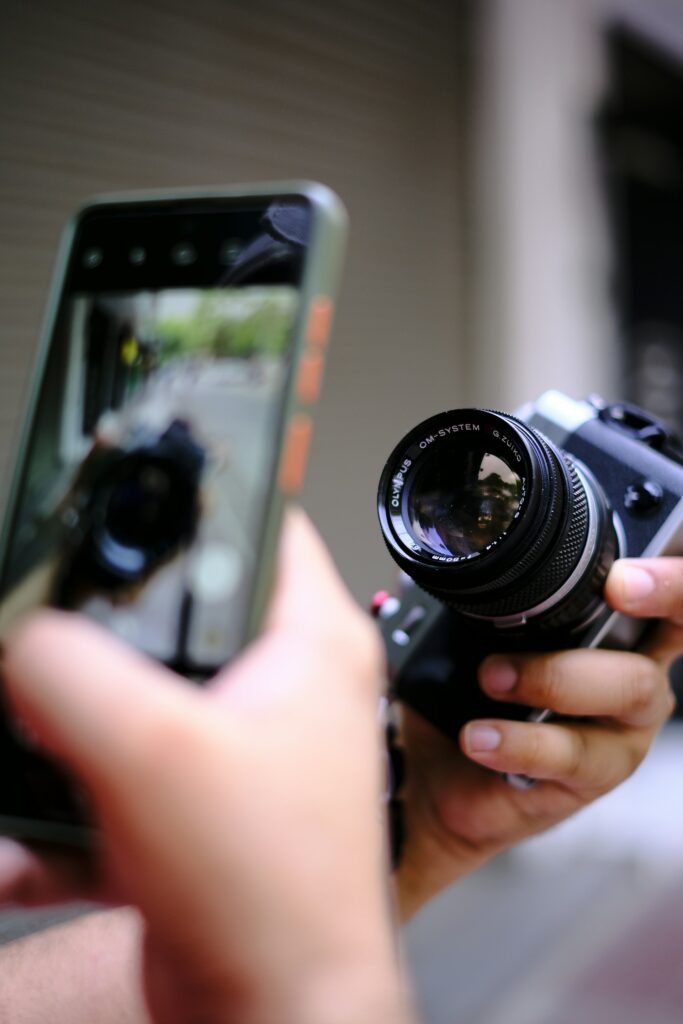A Comparison Between Digital Cameras and Phone Cameras: Are Phones Capable of Taking the Place of Cameras?

A Comparison Between Digital Cameras and Phone Cameras: Are Phones Capable of Taking the Place of Cameras?
The Evolving World of Photography
Over the course of the last ten years, photography has seen a significant transformation. Smartphones, which we carry with us every day, are now often used to complete tasks that formerly required the use of specialist cameras. As smartphone makers invest billions into camera technology, many people are asking: is it possible for phones to really replace conventional digital cameras?
An Explanation of the Way Digital Cameras Function
Digital cameras, including compact cameras, mirrorless cameras, and digital single-lens reflex cameras, employ huge image sensors to collect light with a high degree of accuracy. They make it possible to use professional-quality accessories, manual controls, and lenses that can be swapped out for one another. The quality of the picture, the flexibility of the design, and the creative power that the user has are all given top priority in their creation.
An Explanation of How Smartphone Cameras Function
While smartphone cameras are equipped with significantly smaller sensors, they make up for this with their advanced software, image processing that is powered by artificial intelligence, and the integration of a number of lenses into their thin chassis. For casual photography, the distinction between smartphones and specialized cameras has become less clear because of features like computational photography, night mode, and portrait effects.
Quality of the Image and Size of the Sensor
Digital Cameras: When sensors get larger, they are able to collect more light, which results in improved picture quality, clearer details, and less noise in low-light circumstances. Particularly when it comes to dynamic range and color depth, full-frame cameras are superior to other types of cameras.
Smartphone Cameras: Their tiny size restricts the size of the sensors that they may employ. Even while software does an outstanding job of improving outcomes, it continues to struggle with catching the finer details that are attainable with bigger sensors and with operating in extremely low light conditions.
Adaptability of Lenses
Digital Cameras: The interchangeable lenses that come with these cameras provide unparalleled flexibility. Whether you need to capture a wide-angle shot, a telephoto shot, a macro shot, or a shot using a specialized lens, these cameras provide you the creative freedom you need to handle any circumstance.
Cameras in Smartphones: Although the several lenses that are included into smartphones (ultra-wide, wide, and telephoto) provide versatility, they are unable to compete with the range and optical performance of lenses that are specifically designed for cameras.
Performance in Low-Light Conditions
Digital Cameras: Due to their big sensors and quick lenses, they perform very well in conditions with low light. Even when there is almost no light, professional cameras are able to capture crisp, clear photographs.
Smartphone Cameras: Night settings and artificial intelligence processing enhance the brightness of photographs and minimize the amount of noise that is present in them. However, the resulting images often seem to be artificially processed when they are compared to natural images that are taken with digital cameras.
Capabilities of Zoom
Digital Cameras: Optical zoom, which is achieved via the use of lenses that are either built into the camera or replaceable, preserves both clarity and detail when used at any focal length.
Cameras on smartphones use a combination of optical zoom (which is restricted by the design of the lens) and digital zoom, which results in a decrease in quality. Although the long-range zoom capabilities of the latest periscope lenses are better than those of older models, they are still not as good as those of specialist telephoto lenses.
Depth of Field and Background Blur
Digital Cameras: Genuine optical depth of field produces a genuine background blur (bokeh) without the need of software gimmicks. The ability to change the aperture enables for the artistic separation of objects from their surroundings.
Smartphone Cameras: Depend on portrait modes that are reliant on software. The results are getting better, but there are still some difficulties with hair, spectacles, and complicated edges.
Velocity and Performance
Digital Cameras: They are essential for sports and wildlife photography because they have faster focusing capabilities, can shoot in quick bursts, and are able to follow moving objects more effectively.
Smartphone cameras, which are perfect for taking pictures of ordinary life and are quick to use, are not, however, designed to photograph things that are moving rapidly at a professional level of quality.
Portability and Convenience
Digital cameras are more cumbersome than other types of cameras, and they also need the carrying of additional lenses or accessories. Most appropriate for photographic sessions that are devoted to the task
Smartphone Cameras: They are always with you, they are available to use at a moment’s notice, and they are linked to applications that allow you to quickly edit and share photos. its most significant advantage is its convenience.
Recording of Video
Digital Cameras: Provide high-quality video recording, bigger sensors for cinematic depth, and professional controls such as interchangeable lenses and external microphones.
Smartphone cameras are capable of recording video at resolutions of up to 4K and even 8K, and they provide outstanding stabilization; but, they are restricted by sensor size and heat management.
Considerations of Cost
Digital cameras are a significant financial commitment. Although camera bodies and lenses might cost hundreds of dollars, they produce professional-level images.
Smartphone cameras have become more inexpensive since they incorporate a variety of tasks into a single device. In terms of informal usage, high-end cellphones are comparable to entry-level cameras.
Who Should Opt For Digital Cameras?
- People who earn a living by taking photographs professionally
- Serious enthusiasts who desire creative control
- Photographers specializing in sports, animals, or events that need speed and variety
- Anyone who is primarily concerned with achieving the highest possible visual quality
Who Should Opt for Smartphone Cameras?
- Everyday people taking photographs of their families, travels, and social media occasions
- Individuals who place a high value on mobility and ease
- Photographers who take pictures as a hobby and need high-quality shots but do not want to use any additional equipment
Is It Possible for Phones to Take the Place of Cameras?
For the majority of people, cellphones have practically supplanted small point-and-shoot cameras and even entry-level models for daily shooting, so yes, they have. On the other hand, digital cameras continue to be an essential tool for professional work, specialist genres, and circumstances that need the highest possible quality. Smartphones will probably continue to shrink the gap in the future, but dedicated cameras will always have a role in serious photography.
Smartphones have made photography more accessible, powerful, and portable, which has resulted in a transformation in the way photography is practiced. Nonetheless, despite the fact that they are more than sufficient for ordinary users, digital cameras continue to reign supreme for pros and enthusiasts who are in pursuit of the best in quality and control. The two technologies, cameras and phones, exist side by side rather than replacing one other. Cameras are used for instances when photography is of the utmost importance, while phones are used for daily convenience.




